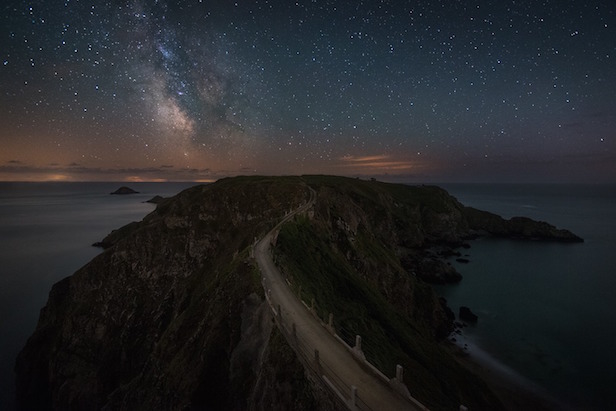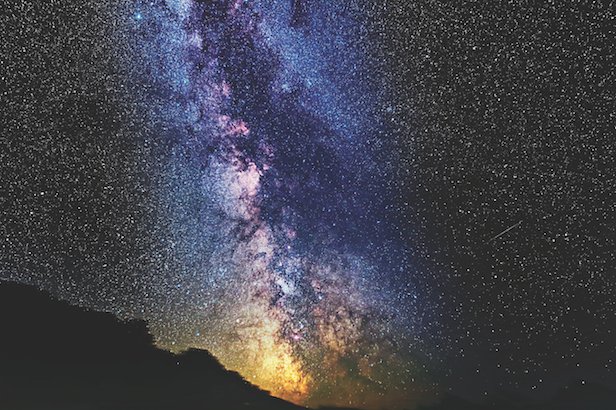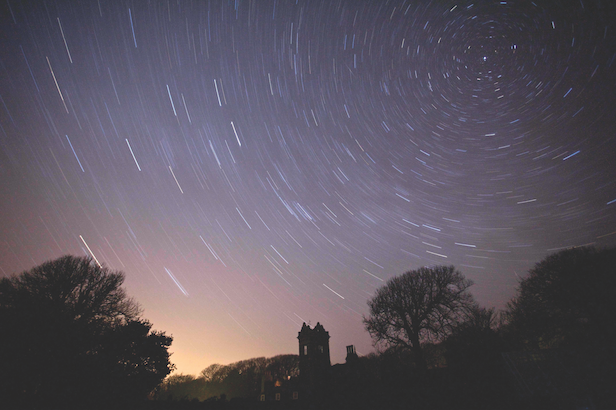SPONSORED: Wish Upon a Star in Sark
This August, 7-15th, come to Sark to witness the Perseid Meteor Shower peak and hear expert talks from Professor Ian Morison and Robin Scagell

Enjoy some of the most highly-envied dark skies in Sark. Image credit: C&C Marc Whitehead Photography (Jersey)
In January 2011 Sark of the Channel Islands gained the distinction of being awarded International Dark-Sky Association recognition for its exceptional quality of unpolluted darkness, and became the first functioning island community to gain this title.
What does it mean? Sark, although very tiny, has a thriving population of around 600 people. We have everything this modern world can offer except motor cars and all they entail. This restriction means that our nights are truly dark, the planets of the Solar System easily distinguished, the stars a magnificent backdrop. Air quality is unsullied, sunsets and dawns spectacular, the Milky Way a brilliant belt strung across the heavens.
You do not need to be an astronomer to appreciate dark skies; they inspire poets, artists and lovers. However, if you are in any way, shape or form interested in what lies beyond our home planet, Sark is a place you will appreciate – and it’s on your doorstep.
People who live under bright stars tend to take them for granted, a mere adjunct to all the other beauties of island life.
However, the less fortunate can hardly believe how amazing and awe-inspiring an unpolluted night sky can be. Their first visit to Sark can be, quite literally, an eye-opener.
Nights on Sark are very quiet, very dark and utterly peaceful. There are no street lights, and the light pollution which plagues stargazers who live in towns and cities is absent, so on looking up into the night sky it seems you can see a million billion stars.
In summer, the nights are warm with a velvety black sky. At the height of summer the night is only six hours long, so stargazers have a limited time to appreciate the glories above. However, wandering around Sark’s dark lanes in winter is a different experience, the pungent smell of wood fires replaces the sweet scent of honeysuckle. Orion the Hunter strides across the sky, the Milky Way sprinkles lights across the island. If time and trajectory are known, it is easy to spot the International Space Station passing overhead. Meteors, with their distinctive long tails, seem to pass quite slowly and may be visible for a few seconds. For those prepared to wrap up warmly and stay up there is a treat in store as the Earth could be showered in fireballs seeming to emanate from the constellation of Leo in November. Named the Leonids, this meteor shower is a wonderful display of shooting stars. Over 2,000 an hour were observed in some parts of Europe in 2002. The Perseids put on a more modest but reliable show of shooting stars every August.
EVERY YEAR FOR NEARLY 60 YEARS
A favourite children’s activity on Sark that’s perhaps not so readily available elsewhere? With the lack of cars, slow pace and genuine small-community culture, children revel in the freedom of going places on their own, and even doing their first food shop by themselves, unaccompanied and unassisted.
Hmmm. Really?
While that might not sound very exciting, and perhaps even boring, there’s a family that’s been coming to Sark every year for nearly 60 years, staying anywhere from a couple of weeks to a month, now with generations of great-grandchildren, spouses, partners, cousins and friends in a huge extended family. There’s been as many as 50 to 60 of the extended family on island all at one time! And having talked personally to many of the children, from 5 to 14 years old, they say they will always come to Sark every year, always.
HUNDREDS OF METEORS ON SARK!
When will there be hundreds of meteors?
Each year the Perseid Meteor shower occurs from around 17 July to 24 August. During that period there is usually a peak, and sometimes more than one, with an increased number of meteors. Often this is around the 12 August, and on rare occasions a peak could become an ‘outburst’ with many more meteors, as in 2016. This year the Perseid meteor peak is anticipated one day after a new Moon, so the sky will be especially dark.
Will there really be hundreds?
The number of meteors gradually increases as the anticipated peak occurs, averaging from 40 to 80 per hour, increasing to as many as 110 to even 140 an hour. While these are theoretical rates and include the very faintest, over a period of a few hours it should be possible to see several hundred meteors given clear skies.
What else will be happening besides the Perseids meteor shower?
Between 7 to 15 August, Professor Ian Morison and author Robin Scagell will be on Sark giving evening talks on a wide variety of topics and guiding telescope observation sessions. Public viewing will be available during the day with a solar telescope, and evenings with an 8-inch Meade with motor drive and Go To, a 12-inch Dobsonian and the 10-inch Meade at the Sark Observatory.
This Perseids meteor shower peak sounds special, does it happen all the time?
The next time the Perseids peak when it’s a new Moon is 2026, eight years from now, so yes this year is a bit special, and a good time if you have ever had a dream to ‘Wish Upon a Star‘ in Sark. The planets Mars, Jupiter and Saturn will all be on show, and with the new Moon we can observe a wide range of star clusters, nebulae and galaxies to be decided at the time.
Sometimes astronomy and telescopes sound technical – what if I’m new to astronomy?
No experience is necessary to enjoy stargazing, with expert guides Ian Morison and Robin Scagell. Ian is a keen amateur observer and is an expert on taking photographs through amateur telescopes. Ian’s career at the Jodrell Bank Radio Observatory involved him in many exciting projects. Robin Scagell was given the Sir Arthur Clarke Award for Space Reporting, has authored many popular astronomy books and even has an asteroid named after him!
Why go to a Dark-Sky location? Won’t I see meteors where I live?
The Perseids are famous for a higher number of fireballs, so bright they can be seen during the day. You can see some meteors where you live, but it might take a while of vigilant watching. More faint meteors can be seen in darker skies, so the darker the skies, the more stars to ‘Wish Upon’! Even better, on a Dark-Sky Island location like Sark, distinct meteor colours and the full extent of the meteor tails are visible.
Why Sark? Can’t I just go to a dark area close by?
Light pollution affects a surprisingly large area. Sark has some of the darkest skies in the British Isles, Bortle Class 3, with some dark-sky readings that qualify for Bortle Class 2. There are only two other places in the British Isles with skies as dark as Sark, in remote areas of Scotland.
This sounds great! So where do I stay on Sark?
Camping outdoors is ideal for meteor-watching, giving you a perfect view of all the stars. So if you want to make the most of your stargazing experience, book at one of Sark’s two campsites on sark.co.uk. The island also provides a safe environment for children who enjoy seeing the universe, but places are limited, so don’t wait to book to ‘Wish Upon a Star in Sark’, between 7 to 15 August – you’re in for a blockbuster astronomy week!
EVENTS
Since our first Starfest celebration in October 2011, SAstroS has hosted two such events a year in autumn and spring. This year come join us to ‘Wish Upon a Star in Sark’ Perseids Meteor shower, 7 to 15 August, joining Professor Ian Morison and author Robin Scagell for talks and nighttime observations. Previously we have welcomed guest speakers, including:
Professor Andrew Coates, head of planetary science at Mullard Space Science Laboratory
Dr Marek Kukula, public astronomer, Greenwich Royal Observatory
Dr Chris Linott, Oxford University and presenter of BBC Sky at Night
HOW TO GET THERE
Travelling to Sark must be by boat from Guernsey or Jersey, which in turn can be reached by air or ferry. For full details, go to darkskyisland.net, and sark.co.uk, email [email protected] or 01481 832345.
INSPIRATION

Sark is devoid of light pollution, offering splendid views of the Milky Way. Image credit: Jonathan Blake
Be inspired to come dream with us to ‘Wish Upon a Star in Sark’ during the Perseids Meteor shower, 7 to 15 August, joining Professor Ian Morison and author Robin Scagell for talks and night-time observations. Sark is the Dark-Sky Island inspiration for Enya’s album of the same name, and the new book Sark in the Dark: Wellbeing and Community of the Dark Sky Island of Sark by Ada Blair. National Geographic Traveler magazine chose Sark as a top 20 must-see destination in ‘Best Trips’ in 2015. Go to darkskyisland.net.








